Embracing your inner Picasso can be tricky with a dog in the house.
But don’t worry — there are plenty of pooch-safe paints you can use to keep the colors of your house, your furniture, and even your actual pet looking great! That’s right, there are a few paints and dyes you can use to turn your canine into a kaleidoscope!
You just need to do your homework first to keep your four-footers healthy. Let’s run through what to look for before purchasing paint, and discuss the best Fido-friendly options together.
Dog-Safe Paints: Key Takeaways
- No matter the application, dog owners should always use pet-safe paints. This includes those times when you’re painting the walls of your living room, applying a fresh coat to your fence, making pup paw print art, or actually dyeing your doggo’s hair.
- Pet-safe paints have a number of common features. Paints and dyes that are safe for pets are made with out heavy metals, volatile organic compounds, or dangerous solvents.
- Just want a quick product recommendation? Use Milk Paint for painting your home or furniture, or go with PetWay Pet Care Paint to color up your canine! Want to make paw prints? Go with Pearhead Pet Paw Ink to keep your pooch’s feet ink-free.
- In addition to using paints that are safe for dogs, you’ll want to employ some common sense strategies while painting. This includes things like keeping your dog away until the paint dries and ensuring there’s plenty of ventilation.
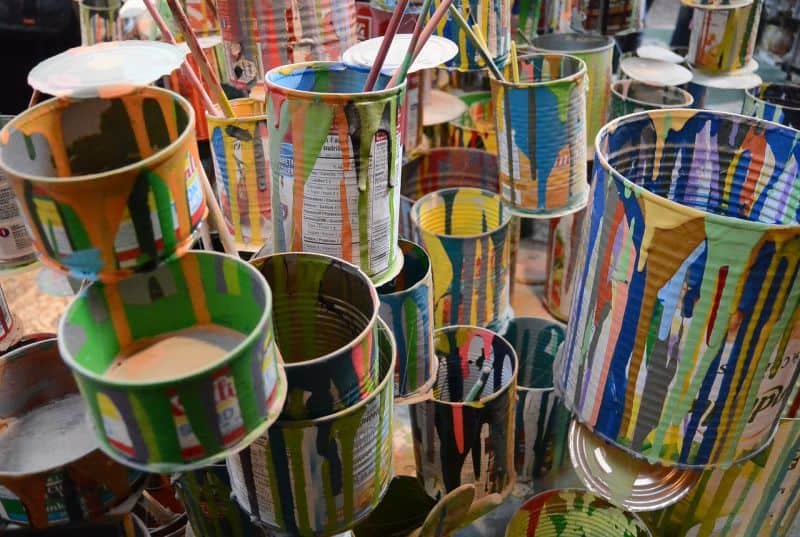
What Makes a Paint Safe or Dangerous for Dogs?
Whether you’re painting your porch, patio, or papillon, you must select paints that are safe to use around pooches.
We all know that paint has a strong scent that can trigger headaches, but those fumes can seriously harm your pooch.
Doggos are extremely sensitive to the heavy metals, volatile organic compounds (VOCs), and solvents sometimes found in paint. Dizziness, hair loss, and more serious canine ailments can occur from simply breathing in noxious paint fumes.
A curious canine can also run into trouble if she licks or chews paint, whether it’s fresh or dried. This is a major concern if you have a teething puppy in the house, who may mistake your freshly painted banister for a fun chew toy. This makes finding a non-toxic, pet-friendly paint a must, especially for places your pup might chomp.
Just be sure to check paint ingredients closely, not only for your dog’s safety, but your own as well.
And remember: Actual paint isn’t the only culprit here. Varnishes, clear coats, primers, removers, and more can all be dangerous to your four-footer and should be approached with the same care.
And if you’re thinking about painting your doggo’s fur or paws, even more care is required, for obvious reasons. You don’t want to coat your canine in a layer of potentially toxic paint or dye.
Just be sure to seek out non-toxic and dog-approved formulas when coloring up Cocoa. This should be clearly stated on the label. Never use human dyes, skin paints, or similar products on your dog. If you’re unsure whether or not a given product is safe, check with your vet.
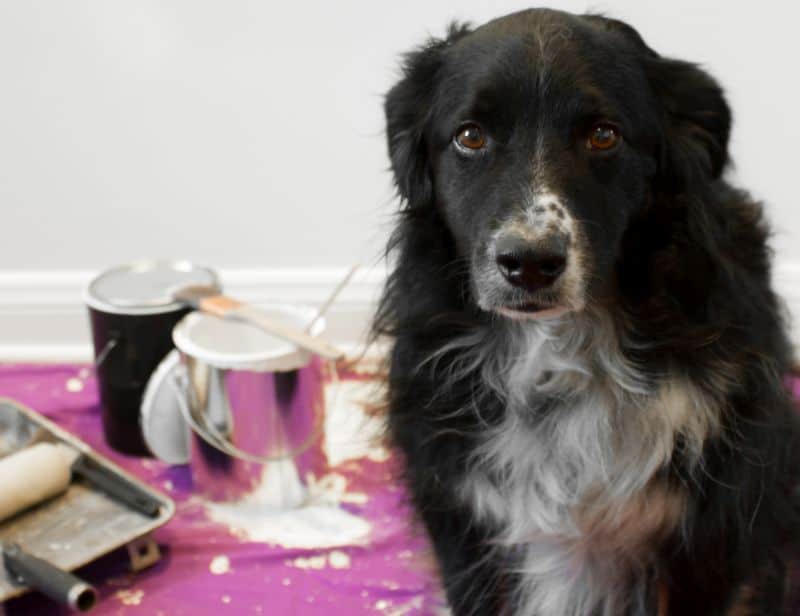
What to Look for in a Dog-Safe Paint?
When paint shopping, seek out a water-based formula and closely examine the ingredients list. Avoid paints with VOCs, heavy metals, and creosote, as we discussed above.
If you can’t avoid VOCs entirely, at least get a low-odor, low-VOC formula, and follow safe painting protocols (such as keeping your dog away while you’re painting and ensuring plenty of ventilation) for a healthy outcome for everyone.
While it isn’t a must, a quick-drying formula is incredibly helpful for pup parents painting on a time crunch. It can be the difference between waiting a few hours versus waiting over a day to use an area again.
Consider the color carefully too. Darker shades, for example, can help hide dirt if you’re painting a heavily-trafficked doggo area, such as near his bed. If you’re concerned with your dog’s heavy shedding showing year round, select a color closer to her fur’s hue. Picking a satin finish with sheen is also ideal, as they can be wiped clean as needed.
The Best Dog-Safe Paints
With safety in mind, we’ve retrieved some of the best dog-friendly paints out there, whether you’re looking for something to paint your house, your doggo’s DIY dog house, or your pooch’s ‘doo.
1. Milk Paint
This is a sponsored placement, in which an advertiser pays a fee to be featured in this article. Learn more
About: Real Milk Paint’s Milk Paint is an all-natural milk powder paint that won’t leave you and your doggo choking on paint stink for days. Just add water, mix, and start your project.
Features:
- Made in the USA
- Non-toxic formula that’s safe for use around pets and kids
- An environmentally friendly paint made with organic materials
- Stylish matte finish
Options: There are dozens of colors to choose from, and size options vary from a pint to a gallon. You can also purchase small sample sizes if you’re unsure of a shade.
PROS
The lack of heavy fumes makes this a top contender for indoor painting. Since it’s non-toxic, it’s also an excellent choice for areas your dog may lick or chew, like baseboards, furniture, and railings. The earth-friendly ingredients are a big perk with nature-loving fur families, too.
CONS
Pricing is a bit higher than traditional paint, and with multiple coats needed, it can raise your project budget. This formula also isn’t waterproof — a real drag in a doggo household. You would need to take additional steps to waterproof it, requiring more work and additional products that aren’t necessarily as pet-safe depending on the manufacturer.
2. Petway Petcare Pet Paint Spray
This is a sponsored placement, in which an advertiser pays a fee to be featured in this article. Learn more
About: Petway Petcare Paint is a spray-on dog hair dye product that’ll let you color up your canine in an easy, yet safe, manner. This is a temporary product, which is designed to color your pet’s hair, without causing skin discoloration.
This is a propellant-free paint, making it even safer than some others, but it still discharges like a typical aerosol product.
Features:
- Easy to use
- Quick-drying formula is easier on pooches
- Simply give your pooch a bath (with dog-friendly shampoo) to remove
- Packaging includes unique Flairosol dispenser, alleviating the need for propellants
Options: Petway Petcare Paint is available in nine bold colors.
PROS
Most owners who tried these paints liked the way they worked. They appear to work well, go on easily (though it is recommended that you wear gloves), and they seem to wash out without a problem. One owner reported that the paint lasted about three days, which we think is a nearly ideal length of time.
CONS
Honestly, we typically prefer recommending products that have more owner reviews than Petway Petcare Paint enjoys, but the bulk of the reviews that do exist are positive. The negative reviews are primarily about colors not exactly matching owner expectations, which is a minor issue.
3. PetPaint Pet Hair Spray
This is a sponsored placement, in which an advertiser pays a fee to be featured in this article. Learn more
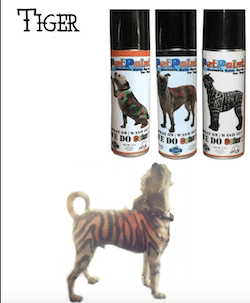
PetPaint Pet Hair Spray
Veterinarian-approved hair paint for dogs
About: PetPaint’s Pet Hair Spray allows your creativity to go wild while styling your pet. Whether you’re freehand spraying or stenciling, you’re sure to achieve a memorable look.
Features:
- Veterinarian tested and approved
- Easy to use — just aim, spray, and enjoy
- Formula is easy to wash away and clean up as needed
- Offers full control with its spray design
Options: There are 9 color options to choose from, along with 4 glitter spray shades.
PROS
The colors are more vivid than using chalks, and your dog won’t be stuck rocking a color for long if it’s just for a quick holiday look. The application is far less of a headache than using gel dyes, too. The lack of smell is another hooray for doggos and pup parents alike.
CONS
It can be difficult to use if you have a wiggly pup, potentially leading to an oops or two. The pain’ts staying power is also questionable, though the manufacturer sells a setting spray that can help lengthen wear if you’d like. Some dogs may dislike the spraying sound, too.
4. Opawz Dog Hair Gel
This is a sponsored placement, in which an advertiser pays a fee to be featured in this article. Learn more
About: Opawz Dog Hair Gel is a fur-friendly formula made with non-toxic ingredients. It can be used for full-body coloring or spot styling, with the 4-ounce tube providing enough dye to color a small to medium-sized doggo.
Features:
- Lasts for multiple washes and fades gradually
- Low-odor dye
- Results vary by your dog’s color and coat, with best results on white and light-colored pooches
- Should only be used on pups 6 months and older
Options: Available in both permanent and semi-permanent varieties, there are 15 vibrant colors to pick from.
PROS
The color results are impressive, even on some darker doggos. Staying power is a win too, with the color lasting for multiple washes. And because the product is packaged in a tube, you’ll enjoy a bit more control than tub or pump packaging, which is another big plus.
CONS
Because this is a gel dye formula, it can get messy, so make sure you keep cleanup items handy to prevent your bathtub from staining. Using gloves is a must too to avoid dyeing your hands. Ideally, the gel should sit for at least 15 minutes before rinsing, which can be a challenge for some dogs.
5. Pearhead Pet Paw Print Ink
This is a sponsored placement, in which an advertiser pays a fee to be featured in this article. Learn more
About: Pearhead’s Paw Print Ink Kit allows your pooch to leave her pawprint on your home’s walk of fame, a photo, or any other art project you’d like.
But here’s the cool-thing: Your dog never actually touches the ink! This kit is designed to be used “upside down,” so that the simple pressure from your pupper’s paws creates the image.
Features:
- Easy to use
- Mess-free, as your dog never comes into contact with ink
- Allows for two-time use, giving you a backup in case there’s an oops
- Compatible with almost all dog breeds
PROS
The no-mess design beats dealing with pet-safe paint, a brush, and your pup. The result is often a cleaner overall look rather than paint, too, making it ideal for scrapbooking and frame transfers.
CONS
Any dog that dislikes her feet touched will likely despise this concept, but with some treats and patience, you could end up with a usable print. The ink pad may be too small for jumbo four-footers, however.

Paint and Pooches: General Tips
Painting as a pup parent doesn’t have to be a problem. You can make painting your home, fences, or furniture easier and safer by following a few simple steps:
- Pre-painting fun: Since you’ll be occupied for a bit, a long walk or play session with your dog beforehand can make a world of difference. Tiring her out (and squeezing in potty breaks) can help her relax while you get to work.
- Keep away: Use a dog crate or x-pen to corral your dog far from the painting area. This keeps her out of trouble (and your paint can!) It might be a good day to flex her muscles at doggy daycare, too.
- Ventilate: Your dog’s nose is much more powerful than yours is, leaving her vulnerable to strong scents, like paint. Not only that, but those fumes are dangerous for you and your pupper to inhale. Always paint in a well-ventilated area and take breaks with your dog as needed. Keep the air flowing until the paint dries and the smell dissipates.
- Take it outside: If you’re painting furniture or a small project piece, try to complete the job outdoors. This keeps the fumes and paint away from your pooch while providing unlimited ventilation for everyone’s safety.
- Safe storage: Always store paint and painting supplies in an area that is out of your dog and children’s reach.
If you’re seeking to color your dog with a fur paint, you need to be extra careful and take additional precautions, such as:
- Dog-safe only: If the label doesn’t clearly state dog-friendly, we would not use a product. Consult your veterinarian and/or the manufacturer if you’re unsure.
- Your dog’s comfort level: Not every dog will tolerate painting or dyeing. Consider your pooch’s ability to withstand what goes along with it, such as standing, waiting for the color to set, and washing/rinsing.
- Your dog’s personality: If your pooch is a big-time licker or self-groomer, dog dye or fur paint aren’t the best options. There’s a chance he could ingest some and have tummy trouble.
- Your dog’s health: Pups with skin conditions or allergies are not the best candidates for doggy hair dye or fur paint. If you’re unsure, call your vet.
- Your dog’s age: Most dog dyes and paints should not be used on dogs less than 6 months old.
- Practice safe styling: Never apply paints or dyes to your dog’s face, ears, or private parts. This can cause serious irritation, and trust us, you don’t want to apply topical cream down there.
- Doggo disagreement: Not every dog will react warmly to seeing a fur friend dyed or painted. If you live in a multipet house, this is something to seriously consider to avoid problems.
- Consider alternatives: There are other ways to get a pop of color that aren’t as drastic. You could try dog-safe nail polish or stencil a cute pattern with dog hair dye or chalk.
Dog-Safe Paint FAQs
Painting with a pooch in the house isn’t always easy. There are a lot of variables, from paint types to paint applications. A few of the most common questions are:
What paints are safe for dogs?
For household paints used on walls and furniture, you want a paint that contains low to no VOCs. Ideally, it should also be water-based.
Paints and dyes used on dogs should always be labeled dog-friendly, and you should never use human products on your pooch.
Is it safe to use acrylic paint on my dog’s paws?
Possibly. Some acrylic paints are non-toxic and made specifically for kiddos or canines – we even have a list of the best pet-safe nail polishes! You should always consult the label, the manufacturer, or your vet if you’re unsure.
Never use anything but dog-friendly hair dyes on your dog’s skin.
How can I make a paint safe for dogs?
You can’t make an existing paint dog-safe. Only purchase low-fume household paints for use around the house, and only use fur-dyeing products deemed dog-friendly by the manufacturer on your dog.
Will paint hurt my dog or make her sick?
Using traditional paints around your dog can harm her with the heavy fumes and possible additives. And obviously, doggos who drink paint are likely to become very sick.
Whenever painting, always remove your pup from the area and keep the space well-ventilated until the fumes and smell dissipate.
Is lead-based paint dangerous for dogs?
Yes, lead-based and other heavy metal paints are dangerous for use around dogs (and the rest of your family). Always consult paint labels and work in well-ventilated areas. Never use heavy metal-laden paints in areas your dog may chew or lick in the future.
What kind of paint do I use to make paw prints with my dog?
Some waterproof paints can be safe for paw print capturing. You could also use a doggy hair dye or paint to make the transfer.
Always check your dog’s paw thoroughly before dipping in any sort of paint to ensure there are no cuts, scrapes, or tender spots. Trim her nails ahead of time too for a better overall look.
***
Have you used any of the dog-friendly paints above? Do you use another brand? Let us know in the comments!
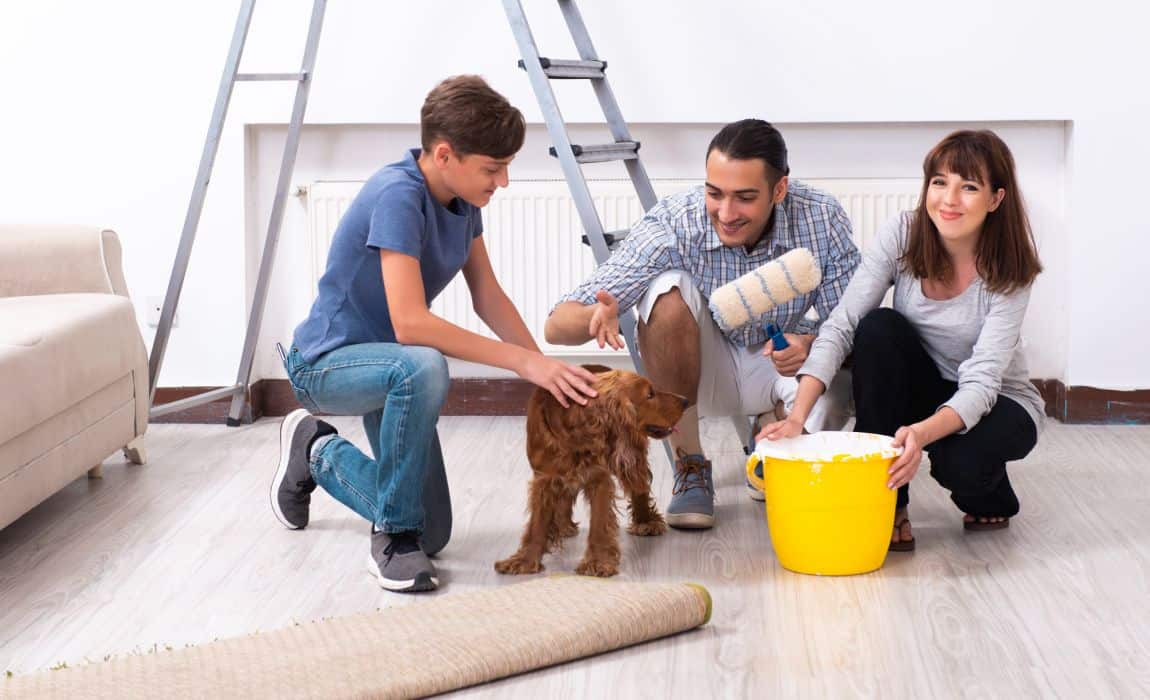





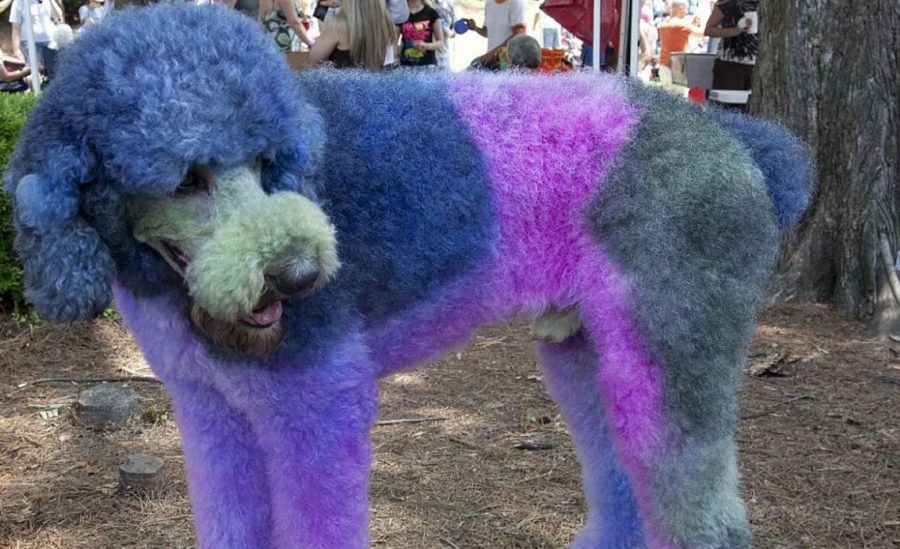



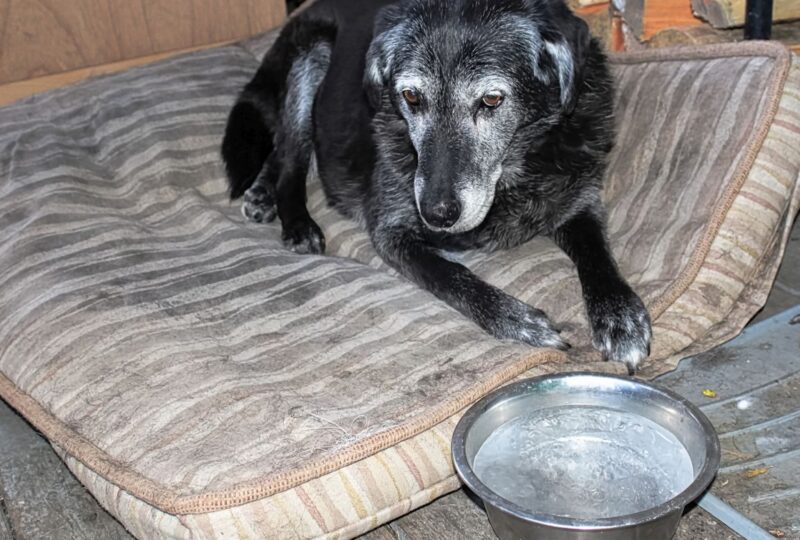
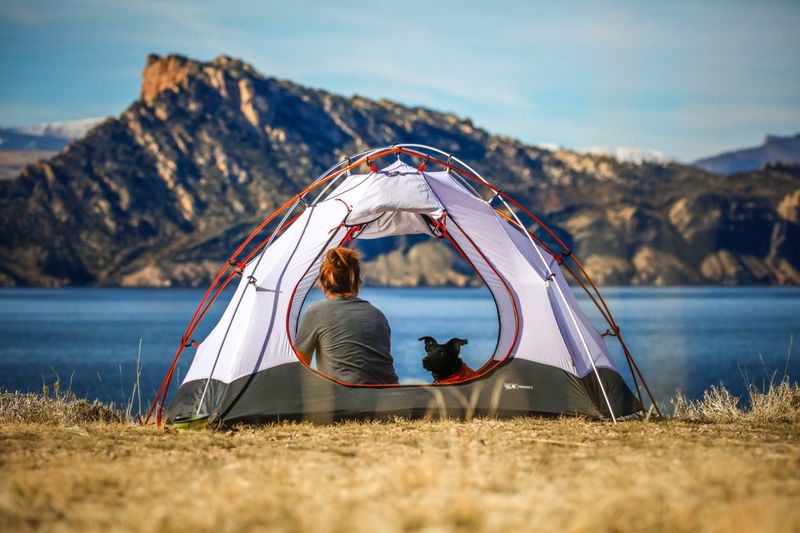
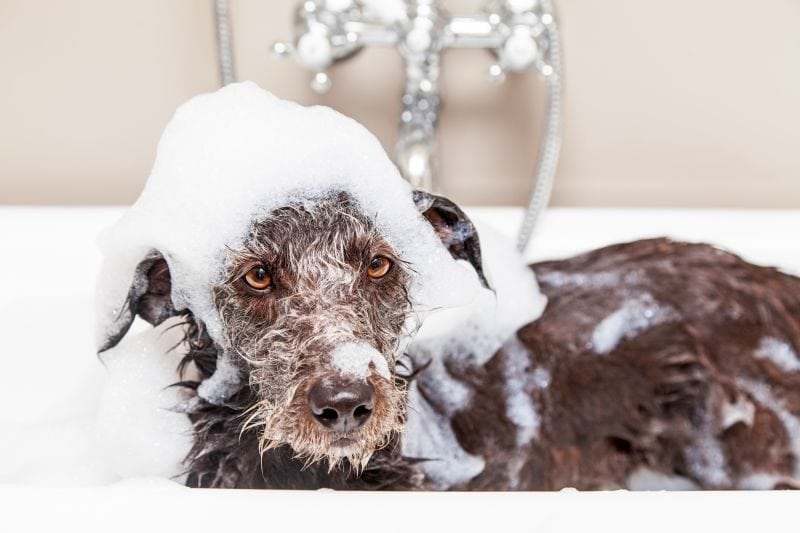


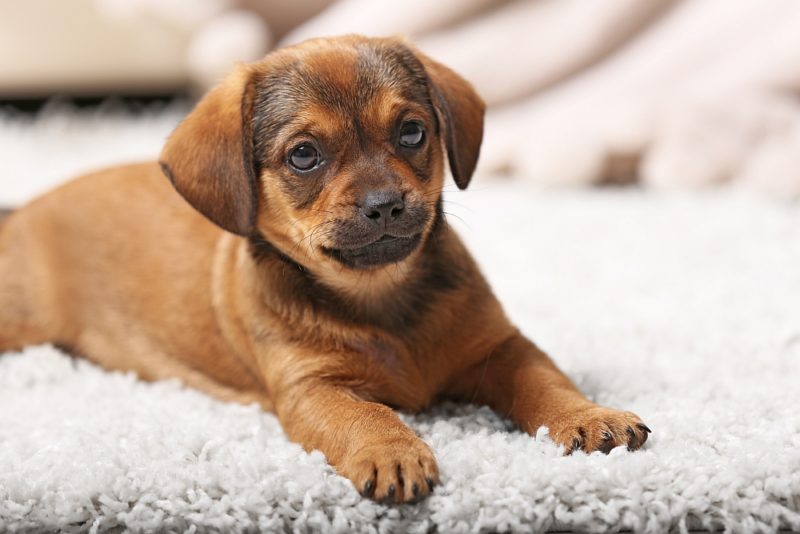

Leave a Comment